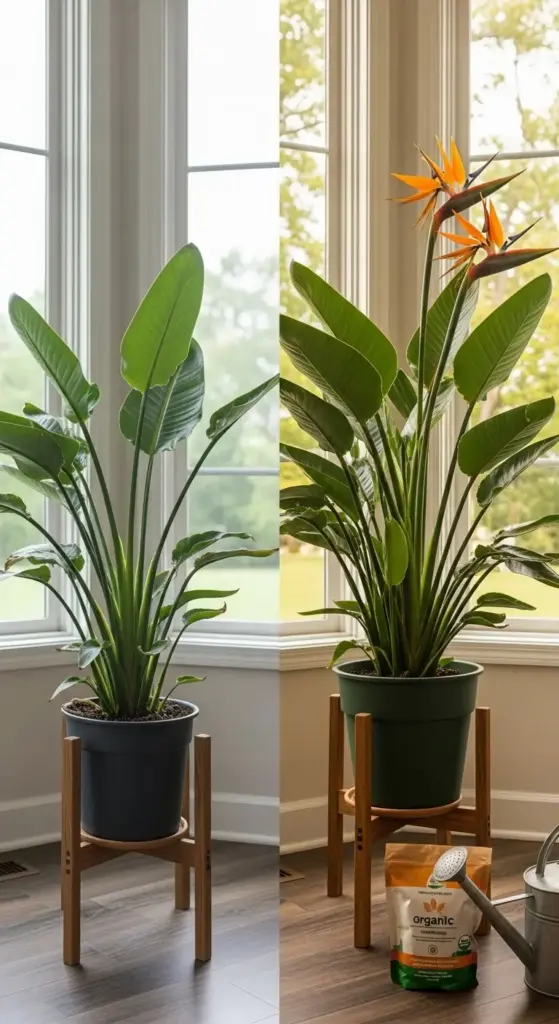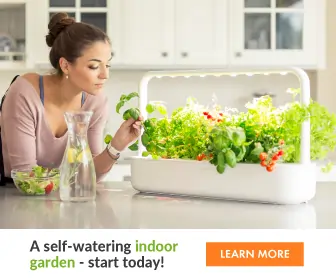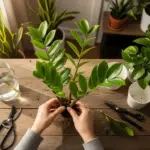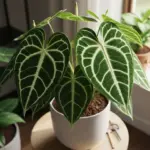5. Feed Your Plant Like a Pro with Strategic Fertilizing

I starved my Bird of Paradise for two years thinking “houseplants don’t need much food.” What a rookie mistake. These fast-growing tropical giants are actually heavy feeders when they’re happy.
The difference between a struggling plant and a leaf-producing machine often comes down to consistent, proper fertilizing. I wish someone had told me this sooner!
Best Fertilizer Types for Explosive Growth
Balanced liquid fertilizers with equal NPK ratios (like 10-10-10) work amazingly well for Bird of Paradise plants. I use them every 2-3 weeks during growing season.
Slow-release granular fertilizers are perfect for busy plant parents. Sprinkle them on soil surface in spring, and they feed your plant for 3-6 months.
Fish emulsion might smell terrible, but my plants absolutely love it. The organic nutrients seem to trigger faster leaf development than synthetic options.
Avoid high-nitrogen lawn fertilizers – they’ll give you lots of leaves but weak stems that can’t support the plant’s weight.
Seasonal Feeding Schedules That Actually Work
Spring through early fall is prime feeding time. I fertilize every 2-3 weeks when my plant is actively growing new leaves.
Winter feeding is tricky. I cut back to once monthly or stop completely if growth slows down significantly.
March is restart month in my apartment. That’s when I see the first new shoots, so I begin regular feeding again.
Watch your plant, not the calendar. If it’s pushing out new leaves in winter (thanks to grow lights), keep feeding lightly.
Organic vs Synthetic: What Really Works
Synthetic fertilizers give faster, more predictable results. My plant responds within days of liquid feeding with noticeably greener leaves.
Organic options like compost tea and worm casting work slower but create better long-term soil health.
Combination approach works best for me. I use liquid synthetic for quick boosts and organic slow-release for steady background nutrition.
Fish emulsion plus kelp meal is my favorite organic combo. Smells awful for a day, but the results are incredible.
Recognizing and Fixing Over-Fertilizing
Salt buildup from too much synthetic fertilizer shows up as white crusty deposits on soil surface or pot edges.
Leaf burn appears as brown, crispy edges even when watering is perfect. I learned this lesson the hard way with overzealous spring feeding.
Flush the soil with plain water if you suspect over-fertilizing. Run water through until it drains clear from the bottom.
Yellowing lower leaves can indicate nutrient burn. Stop fertilizing for 4-6 weeks and let the plant recover.
Signs Your Plant Needs More Food
Pale, small new leaves are classic hunger signals. Healthy Bird of Paradise leaves should emerge vibrant green and full-sized.
Slow growth during prime season (spring/summer) often means insufficient nutrients, especially if light and water are dialed in.
Yellowing older leaves while new growth looks good is normal. But if everything looks pale, it’s probably underfed.
Weak stems that can’t support leaf weight might need more phosphorus and potassium in the fertilizer mix.
Budget-Friendly Fertilizing Alternatives
Banana peels buried in soil provide potassium as they decompose. I chop them up and mix into the top inch of soil.
Coffee grounds mixed with compost add nitrogen, but use sparingly – too much makes soil acidic.
Eggshell water gives plants calcium. I save water from boiling eggs and use it for watering once cooled.
Compost tea costs almost nothing to make. Steep finished compost in water for 24 hours, strain, and use as liquid fertilizer.
DIY Fertilizer Recipes That Work
Basic liquid feed: 1 tablespoon fish emulsion + 1 teaspoon kelp meal in 1 gallon water. Use every 2-3 weeks during growing season.
Slow-release mix: Equal parts worm castings, compost, and bone meal. Sprinkle 2 tablespoons around plant base monthly.
Emergency plant food: 1 teaspoon Epsom salt in 1 gallon water provides quick magnesium boost for yellowing leaves.
Banana peel fertilizer: Blend 2-3 peels with water, let sit 48 hours, strain, and dilute 1:5 with water before using.
Timing and Application Tips
Morning feeding works best because plants can immediately use nutrients for photosynthesis throughout the day.
Water first, then fertilize to prevent root burn from concentrated nutrients hitting dry soil.
Dilute liquid fertilizers to half-strength for regular feeding. Full strength should only be used monthly at most.
Stop feeding 6-8 weeks before your area’s first frost to help plants prepare for dormancy, even indoors.
Conclusion
Your Bird of Paradise doesn’t have to stay small and struggling! With these five insider tips, you’re well on your way to growing a stunning jungle giant that will be the envy of your friends and the perfect backdrop for your home’s aesthetic.
Remember, consistency is key – small daily actions lead to dramatic results over time.
Start with tip #1 today and work your way through each strategy. Your future self (and your Instagram followers!) will thank you when your Bird of Paradise becomes the showstopping centerpiece of your urban jungle.
Which tip are you most excited to try first?









GIPHY App Key not set. Please check settings